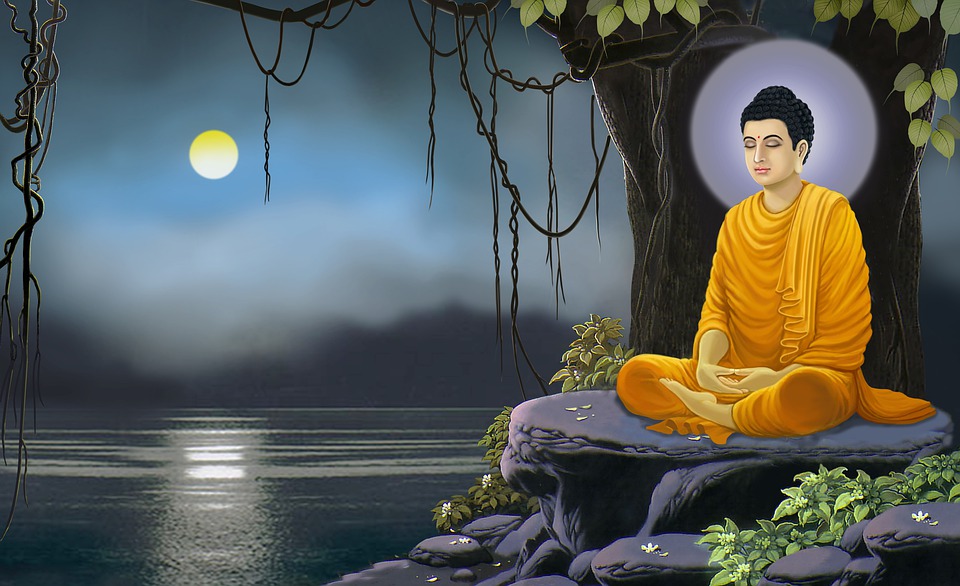The figure we know today as the Buddha was born Siddhartha Gautama, around 500 BCE in Nepal. He lived a very affluent life and had parents that kept him sheltered from all means of suffering and death. Siddhartha’s father would demand that if one flower would begin to droop it would be plucked immediately so his son would not witness its aging. The young prince had no knowledge of what suffering, old age, or even death was.
Siddhartha married and had one child while he lived within his palace. One night when he was 29 years old he set out with his companion and charioteer, Channa. He decided to leave out of curiosity and because he was in search of the “truth”. While they were walking they came across a sick man, a homeless person, and a dead man with people standing around in a circle weeping. Siddhartha had never seen anything like this before and Channa had to explain to him that this is all a part of life.
Witnessing all of the sufferings had a profound effect on Siddhartha. He became depressed and full of despair. While walking he asked Channa about the Yogi under the tree and what it was he was doing. Channa explained to him that he was meditating. Because he looked peaceful, Siddhartha stated that he too was going to sit under this tree until he found the answers he was looking for. He wanted to know why all living things must suffer and why we must die.
Enlightenment
Siddhartha sat under a Bodhi tree and meditated for 45 days while trying to achieve a state of Nirvana. He almost died from starvation. It is said that under this tree he became “the Buddha”, which means ” the enlightened one.” He now knew the answers to suffering and how to defeat it. The answers lie within the “4 Noble Truths” and are stated below:
 1. Dukka; which can be translated into suffering. This means that no matter who we are, we are always changing, and happiness is only temporary. For example, we adopt a sweet little puppy and bring it home to love and take care of. At some point that puppy may get sick, age, or die and we will, in turn, suffer because of it.
1. Dukka; which can be translated into suffering. This means that no matter who we are, we are always changing, and happiness is only temporary. For example, we adopt a sweet little puppy and bring it home to love and take care of. At some point that puppy may get sick, age, or die and we will, in turn, suffer because of it.
2. Samudaya; the cause of Suffering. This means suffering comes from our own minds and is because of our own attachments, arrogance, anger, and ignorance. We as humans have attachments to things that are not permanent. Because these objects are not permanent suffering is inevitable.
3. Nirodha; the Cessation of Suffering. To end suffering is to have no attachment. You must be able to let go of desires, greed, and hatred. You will ultimately need to achieve a state of Nirvana, freedom from all worries and troubles.
4. Magga; to end suffering you must follow “The Noble Eightfold Path”, which is will outline below.
The Eightfold Path is a way to end suffering. This guideline helps free a person from attachments and delusions. “The Four Noble Truths”, and “The Noble Eightfold Path”, are the core of Buddhist teachings.
1. Right View
2. Right Intention
3. Right Speech
4. Right Action
5. Right Livelihood
6. Right Effort
7. Right Mindfulness
8. Right Concentration or meditation
The Buddha decided to teach his philosophies and spread his words to others out of love for humanity. He did not consider himself God or claim to be, instead, he considered himself a “seeker of wisdom”. He began teaching in Benares and had a handful of followers. His first five followers were ascetics like himself, that he lived with. He converted his family and taught his beliefs of kindness and mercy. The Buddha also performed many miracles as he traveled about. His teaching lasted around 45 years as he persuaded men to share in his way of life.
While traveling to Sravasti, he became ill and actually predicted that he would enter into Nirvana in three months. He still continued to travel until a blacksmith made him tainted food. The Buddha became fatally ill. He preached his teachings until the end of his disciples. The Buddha’s last statement was: “Perishable are all conditioned things, but the Truth will live forever! Work out your Liberation with diligence!” He then went into a deep meditation under two Sal trees and quietly passed. He died at 80 years old.
Buddhism Today
Because of the Buddha, Buddhism is the predominant religion in the East ( China, Korea, Japan, and Southeast Asia). His teachings started off as a philosophy and ended up as an organized religion.
The goal in Buddhism is to find peace and salvation through Nirvana. Today there is over 300,000 Buddhists in the United States.
Quick Facts on the Buddha
There was no biography written about the Buddha until hundreds of years after his death.
 He was born a prince and was sheltered from all signs of suffering.
He was born a prince and was sheltered from all signs of suffering.
The Buddha believed in reincarnation or rebirth.
The Buddha was not fat contrary to the statues you see everywhere.
Common statues show the Buddha sitting and meditating with his arms folded and legs crossed, this is called the Lotus position.
The Buddha had one son.
The Buddha was one of the kindest people to ever have existed.
https://www.youtube.com/watch?v=qvC0klpk8nY





